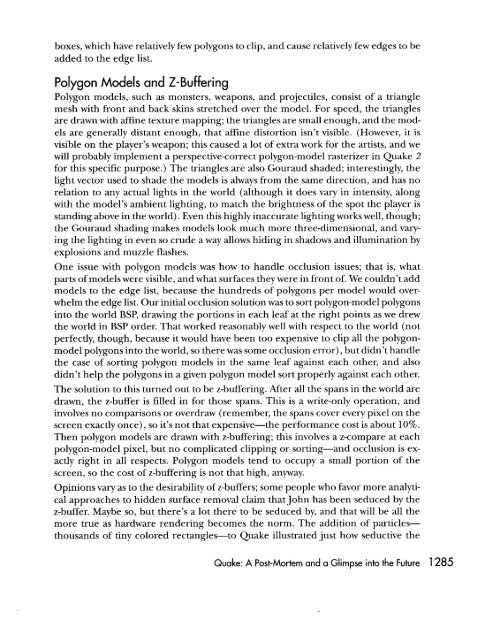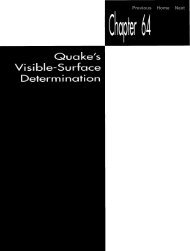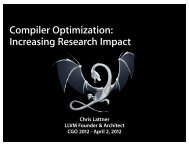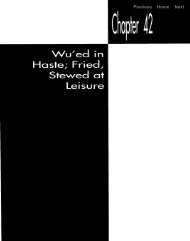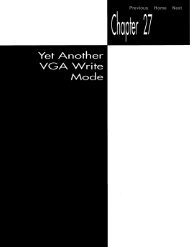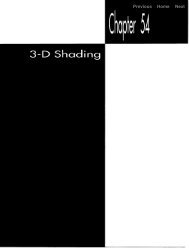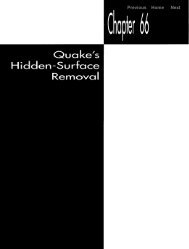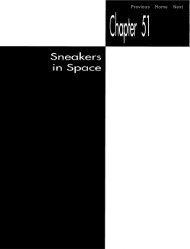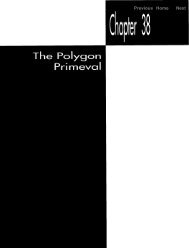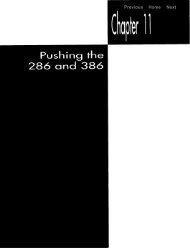quake: a post-mortem and a glimpse into the future
quake: a post-mortem and a glimpse into the future
quake: a post-mortem and a glimpse into the future
Create successful ePaper yourself
Turn your PDF publications into a flip-book with our unique Google optimized e-Paper software.
oxes, which have relatively few polygons to clip, <strong>and</strong> cause relatively few edges to be<br />
added to <strong>the</strong> edge list.<br />
Polygon Models <strong>and</strong> Z-Buffering<br />
Polygon models, such as monsters, weapons, <strong>and</strong> projectiles, consist of a triangle<br />
mesh with front <strong>and</strong> back skins stretched over <strong>the</strong> model. For speed, <strong>the</strong> triangles<br />
are drawn with affine texture mapping; <strong>the</strong> triangles are small enough, <strong>and</strong> <strong>the</strong> models<br />
are generally distant enough, that affine distortion isn’t visible. (However, it is<br />
visible on <strong>the</strong> player’s weapon; this caused a lot of extra work for <strong>the</strong> artists, <strong>and</strong> we<br />
will probably implement a perspective-correct polygon-model rasterizer in Quake 2<br />
for this specific purpose.) The triangles are also Gouraud shaded; interestingly, <strong>the</strong><br />
light vector used to shade <strong>the</strong> models is always from <strong>the</strong> same direction, <strong>and</strong> has no<br />
relation to any actual lights in <strong>the</strong> world (although it does vary in intensity, along<br />
with <strong>the</strong> model’s ambient lighting, to match <strong>the</strong> brightness of <strong>the</strong> spot <strong>the</strong> player is<br />
st<strong>and</strong>ing above in <strong>the</strong> world). Even this highly inaccurate lighting works well, though;<br />
<strong>the</strong> Gouraud shading makes models look much more three-dimensional, <strong>and</strong> varying<br />
<strong>the</strong> lighting in even so crude a way allows hiding in shadows <strong>and</strong> illumination by<br />
explosions <strong>and</strong> muzzle flashes.<br />
One issue with polygon models was how to h<strong>and</strong>le occlusion issues; that is, what<br />
parts of models were visible, <strong>and</strong> what surfaces <strong>the</strong>y were in front of. We couldn’t add<br />
models to <strong>the</strong> edge list, because <strong>the</strong> hundreds of polygons per model would overwhelm<br />
<strong>the</strong> edge list. Our initial occlusion solution was to sort polygon-model polygons<br />
<strong>into</strong> <strong>the</strong> world BSP, drawing <strong>the</strong> portions in each leaf at <strong>the</strong> right points as we drew<br />
<strong>the</strong> world in BSP order. That worked reasonably well with respect to <strong>the</strong> world (not<br />
perfectly, though, because it would have been too expensive to clip all <strong>the</strong> polygonmodel<br />
polygons <strong>into</strong> <strong>the</strong> world, so <strong>the</strong>re was some occlusion error), but didn’t h<strong>and</strong>le<br />
<strong>the</strong> case of sorting polygon models in <strong>the</strong> same leaf against each o<strong>the</strong>r, <strong>and</strong> also<br />
didn’t help <strong>the</strong> polygons in a given polygon model sort properly against each o<strong>the</strong>r.<br />
The solution to this turned out to be z-buffering. After all <strong>the</strong> spans in <strong>the</strong> world are<br />
drawn, <strong>the</strong> z-buffer is filled in for those spans. This is a write-only operation, <strong>and</strong><br />
involves no comparisons or overdraw (remember, <strong>the</strong> spans cover every pixel on <strong>the</strong><br />
screen exactly once), so it’s not that expensive-<strong>the</strong> performance cost is about 10%.<br />
Then polygon models are drawn with z-buffering; this involves a z-compare at each<br />
polygon-model pixel, but no complicated clipping or sorting-<strong>and</strong> occlusion is exactly<br />
right in all respects. Polygon models tend to occupy a small portion of <strong>the</strong><br />
screen, so <strong>the</strong> cost of z-buffering is not that high, anyway.<br />
Opinions vary as to <strong>the</strong> desirability of z-buffers; some people who favor more analytical<br />
approaches to hidden surface removal claim that John has been seduced by <strong>the</strong><br />
z-buffer. Maybe so, but <strong>the</strong>re’s a lot <strong>the</strong>re to be seduced by, <strong>and</strong> that will be all <strong>the</strong><br />
more true as hardware rendering becomes <strong>the</strong> norm. The addition of particlesthous<strong>and</strong>s<br />
of tiny colored rectangles-to Quake illustrated just how seductive <strong>the</strong><br />
Quake: A Post-Mortem <strong>and</strong> a Glimpse <strong>into</strong> <strong>the</strong> Future 1285


